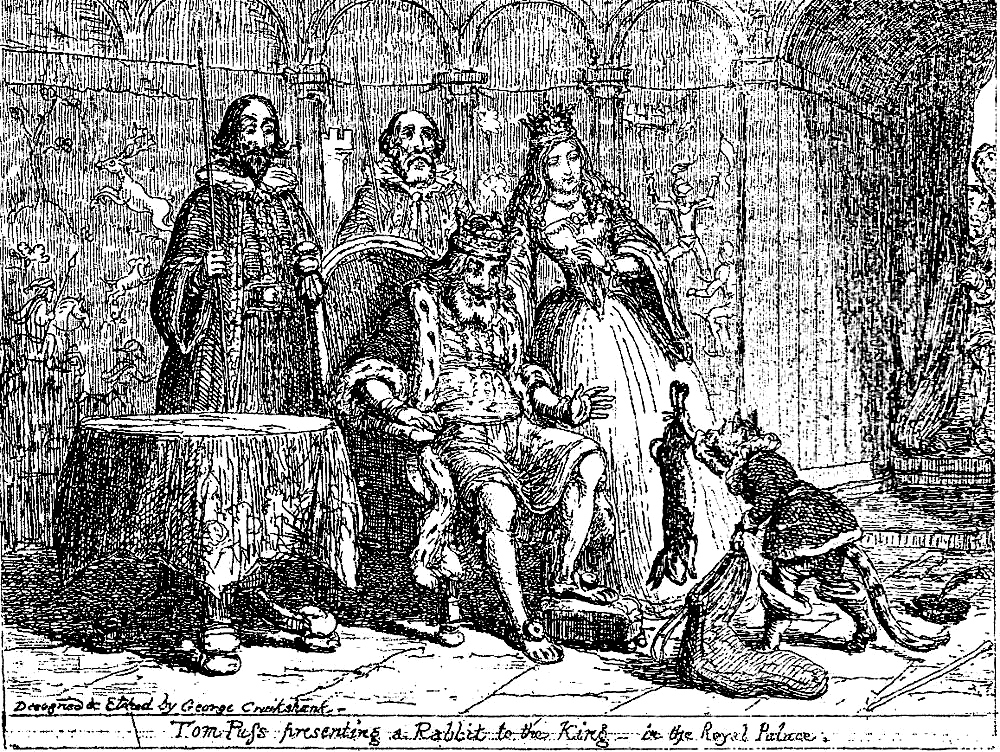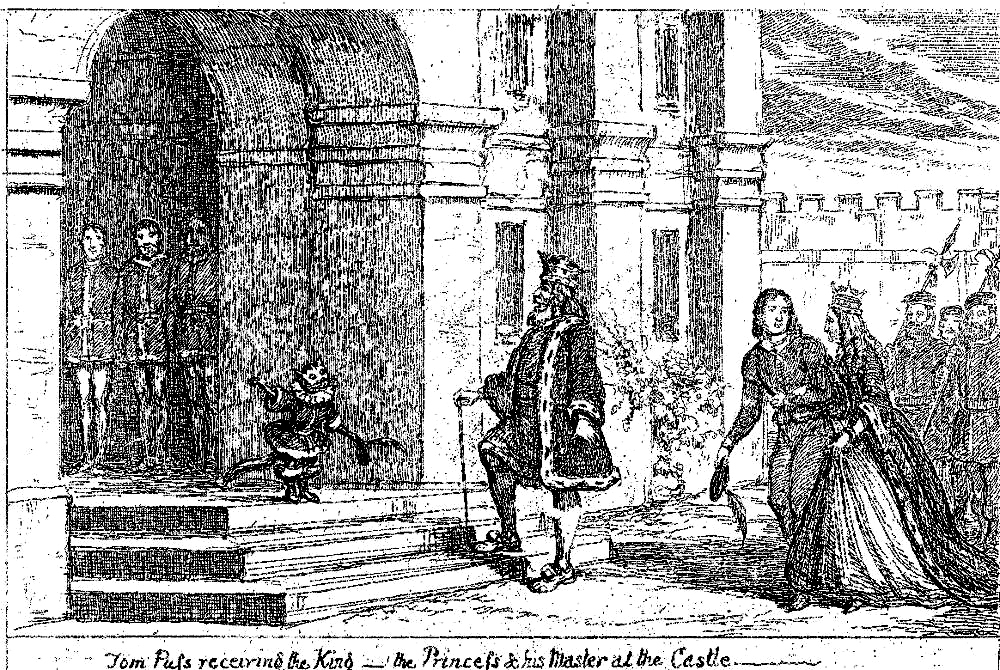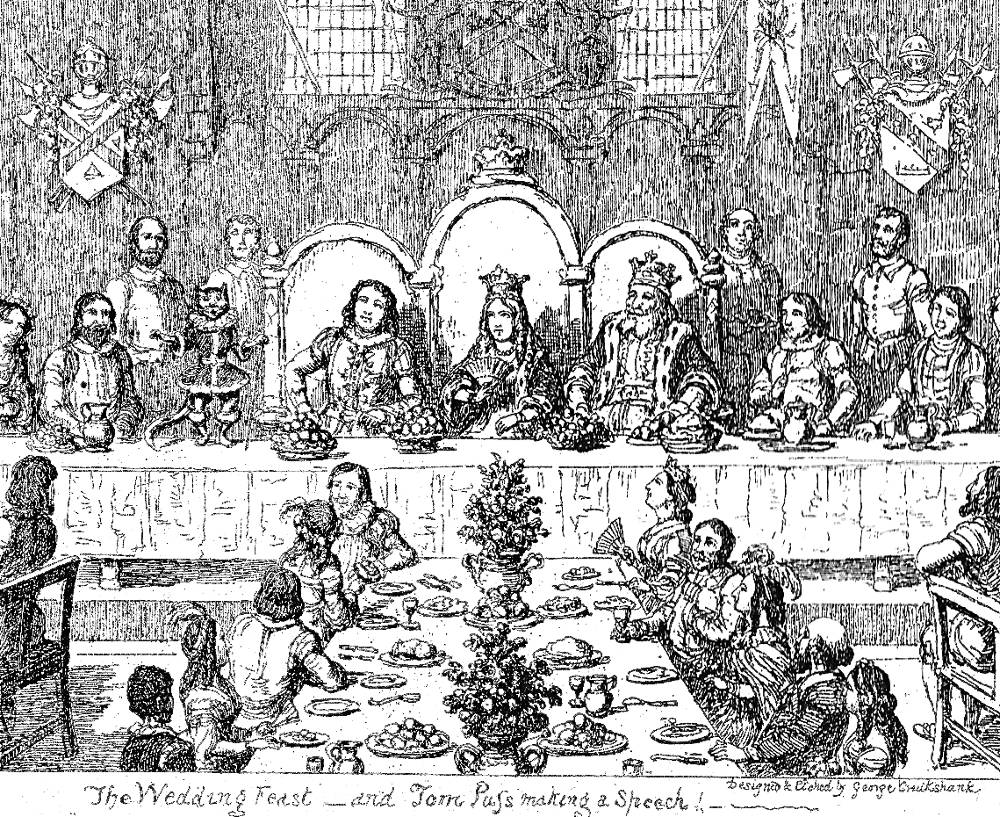
Tom Puss presenting a Rabbit to the King..on the Royal Podium (7 cm high by 9.6 cm wide, exclusive of caption, framed, facing page 8) — the third illustration for both the single-volume edition of 1864 and for the fourth and final tale in the 1865 anthology, George Cruikshank's Fairy Library. Dressed in a suit of clothes worthy of a courtier, Tom Puss now presents a gift from his master, the Marquis (or, as the captions have it, Marquess) of Carabas, to the monarch of the miniature, an elderly gentleman in an ermine-trimmed robe who enjoys rabbit-pie, but has not been able to eat one in quite some time, owing to a shortage of rabbits in the kingdom. Looking on with great interest at a cat who speaks and acts like a nobleman's emissary is the beautiful princess and (hiding behind a partially drawn curtain, right) several servants. The King's gesture reflects his delight with the present of game, whereas the expression on the face of the Chancellor suggests bemusement or utter surprise. Since in the text the recipient of the gift is both "surprised" and "delighted" (9), Cruikshank has had to divide these emotional responses between the King and his chief courtier in order to describe them visually.
Scanned image and text by Philip V. Allingham. [You may use this image without prior permission for any scholarly or educational purpose as long as you (1) credit the person who scanned the image and (2) link your document to this URL.]
The illustrations appearing here are from the collection of the commentator.
Passage Illustrated
Puss set off with a sort of a "hop, skip, and a jump," to the castle, or King's palace, and astonished the guard at the gate by telling them that he had brought a message with a present to the King, and wished to see his Majesty. The chamberlain was informed of this, who lead Tom into the presence of the King and his daughter. Tom Puss made a very graceful bow to the Papa and daughter, and said that his master, the "Marquis of Carabas," having heard that his Majesty was very fond of rabbits, had taken the liberty of sending a brace to his Majesty, which he hoped his Majesty would accept; and as there were a great number on his estate, he would send a supply daily, if his Majesty would allow him to do so. The King was not only very greatly surprised to see such an extraordinary-looking gamekeeper (as puss said he was), but also most highly delighted at the prospect of getting a supply of his favourite food again, told Tom to convey his best thanks to his master, and that he would accept his present and his kind offer of a further supply. The King then asked puss where his master's estate was. Tom pointed out the direction where the Marquis of Carabas' castle was situated. "Why," said the king, "that castle seems to have been shut up for many years." "Yes," replied Tom, "it has so, for the family have been kept out of their estate. For a long time it has been in Chancery, your Majesty; but I expect that the Marquis will be in possession of his castle to-morrow." "Oh, indeed," said the king; "then I'll take my morning ride that way, and perhaps I may have the pleasure of seeing the Marquis." "I am not quite sure," said Tom, "that the marquis will be there to-morrow, but if I see him to-day, I will inform him of your majesty's intention." The kKing then waved his hand, as much as to say you may retire; and Tom Puss stepped backwards from the presence of his Majesty, in doing which he nearly fell backwards, having trodden upon his tail. — George Cruikshank, "Puss in Boots," pp. 9-10.
The Context in Perrault
A rash and foolish young rabbit jumped into his bag, and the master cat, immediately closed the strings, then took and killed him without pity.
Proud of his prey, he went with it to the palace, and asked to speak with his majesty. He was shown upstairs into the king's apartment, and, making a low bow, said to him, "Sir, I have brought you a rabbit from my noble lord, the Master of Carabas" (for that was the title which the cat was pleased to give his master).
"Tell your master," said the king, "that I thank him, and that I am very pleased with his gift."
Another time he went and hid himself in a grain field. He again held his bag open, and when a brace of partridges ran into it, he drew the strings, and caught them both. He presented these to the king, as he had done before with the rabbit. The king, in like manner, received the partridges with great pleasure, and gave him a tip. The cat continued, from time to time for two or three months, to take game to his majesty from his master. — Charles Perrault, "The Master Cat or, Puss in Boots."
Commentary
For Dick Whittington the cat merely does what comes naturally to bring its owner wealth. Puss in Boots, on the other hand, wins for his master, the youngest and poorest of three brothers, the crops and wealth worked for by others through his own deceit and is far more humanized. (Daniels 2002)
In the French original, Puss keeps up the pretext of gifts of game sent to his majesty by his master for several months, whereas Cruikshank moves along the subsequent action, which involves Tom's arranging for the King to come to Caraba's aid, "On the following morning" (11). As dramatised by Cruikshank, Puss is both an endlessly resourceful and highly organised strategist, executing his plan to bring about the marriage of Caraba and the Princess without even bothering to inform his master about the scheme, which next involves Puss's contriving to have Caraba dressed in clothing worthy of a marquis. All that he expects the boy to do is trust his judgment and fully cooperate without hesitation.
Thus, the moralistic narrator mitigates Tom's numerous deceits. His Tom is thus much more of a trickster and psychologist than the cat belonging to the historical Dick Whittington, another legendary figure to whom Charles Dickens alluded on many occasions, in Bleak House, Chapter 6; Barnaby Rudge, Chapter 31; David Copperfield, Chapter 48; Dombey and Son, Chapters 4, 6, and 9; Little Dorrit, Book II, Chapter 12; Martin Chuzzlewit, Chapter 7; and The Old Curiosity Shop, Chapter 50. The number of allusions indicates that, once again, Dickens relished the story of the poor boy who made good in the metropolis; — surprisingly, then, he never alludes specifically to "Puss in Boots" — but then the youth with whom he would identify himself, Caraba, is a mere pawn rather than an active agent.
The composition of the picture takes a commonplace — a courtier offering a present to the King (with only apparent disinterest on the part of the giver) — and making it interesting through subtle details. The tapestry behind the figures, for example, involves the two chief aristocratic activities in the Middle Ages: to the right, knights engage in combat; to the left, hunters pursue a hart with hunting-dogs. So delighted with the gift is the king that he focuses upon it rather than the peculiar giver, although the Princess's gesture betokens surprise. Possessing an intimate knowledge of court etiquette, Tom has left his feathered cap on the flagstone floor, as he bends deferentially while pulling the rabbit out of the bag. A typically Cruikshankian touch is deploying several curious palace servants behind the curtain of the Romanesque arch (right).
The rather Dickensian allusion to the Marquis's property having been in Chancery for a number of years strikes one as something of an anachronism: "For a long time it has been in Chancery, your Majesty; but I expect that the Marquis will be in possession of his castle to-morrow." Later, at the wedding banquet, Tom Puss mentions that the "diabolical" ogre had "placed the whole estate in Chancery" (24), to which Cruikshank appends the satirical note that the minions of the Court of Chancery "in those early times . . . took perhaps ten years to do as much as they do now in ten days" (24).
In his apology for the status quo, Cruikshank even comes to the defence of the court of Chancery (p. 24n.). Could this have been a covert attack on Dickens' condemnation of the court in Bleak House which was published during the midst of their controversy in 1852-53? — The Hockliffe Project, "Fables and Fairy Tales." 0038A: George Cruikshank, Puss in Boots, http://hockliffe.dmu.ac.uk/items/0038A.html
It was certainly not an anachronism when Cruikshank worked the reference into the dialogue to explain why the rightful owner (The Marquis of Carabas) has not been in possession of his property. Only three years after Dickens's death and some twenty years after his completion of Bleak House was the Court of Chancery combined with the Court of Common Pleas and the Court of the Queen's Bench as a single Supreme Court of Justice for England and Wales. Since the function of Chancery was both to settle disputes regarding trusts and legacies and serve as the effective guardian of orphaned beneficiaries whose property was in litigation, the allusion is certainly pertinent:
By the early nineteenth century, overwhelmed with business, it had become a byword for dilatoriness, expense, and antiquated inefficiency. CD suffered from its shortcomings in 1844 when he tried to get it to restrain gross breaches of his copyright in A Christmas Carol; although he won the case, he could not recover his substantial costs. — Nicolas Bentley et al., p. 46.
What is surprising, however, is that the ruler of this tiny kingdom is apparently unaware of the usurpation of the Marquis of Carabas's castle by the ogre, and that the Royal Chancellor at his side, the nominal head of the Court of Chancery, does not correct Tom Puss's assertion. The novel Bleak House, which Dickens completed in September 1853, just before Cruikshank started his Fairy Library project, is an indictment of Chancery, which takes generations to process a case, resulting in the total depletion of the value of the estate in litigation fees. Cruikshank in the 1864 children's book Puss in Boots may have taken issue with Dickens's critique on Chancery, infamous since the eighteenth century for its tardiness and inefficiency in resolving property disputes, simply because of Dickens's having savaged him for injecting progressive political and social views into traditional fairy-tales such as "Hop-p' My-Thumb." And, in fact, the numbers appear to be on Cruikshank's side of the argument since by the end of the 1840s the backlog was being cleared and reform was well underway: the court processed 1,700 cases in 1846–49 compared to 959 in 1819–24. The Suitors in Chancery Relief Act (1852) removed the problem of exorbitant fees by fixing salaries for all court officials salaries, and eliminating sinecures. In consequence, by the early 1860s, an average of 3,207 cases were submitted each year, of which the Court heard and dismissed 3,833, rendering Dickens's fictional long-running Chancery case, "Jarndyce and Jarndyce," specious, or at least unlikely, although ten years earlier the press was full of the widespread criticism of The High Court of Chancery which Dickens's novel reflects. For further details on the powers, responsibilities, and prerogatives of the Lord High Chancellor, see Constitution (1866).
Later scenes involving the King and the Princess

Above: Cruikshank's depiction of Tom Puss's welcoming the King and Princess to his master's (that is, until recently the ogre's) castle, Tom Puss receiving the King .. the Princess & his Master at the Castle (facing p. 22) [Click on image to enlarge it.]

Above: Cruikshank's detailed description of the feast celebrating his master's marriage to the girl of his dreams, The Wedding Feast, and Tom Puss making a Speech! (facing p. 22). [Click on the image to enlarge it.]
Related Materials
- "Frauds on the Fairies" (1 October 1853)
- Editor's Note on "Frauds on the Fairies"
- Defending the Imagination: Charles Dickens, Children's Literature, and the Fairy Tale Wars
- George Cruikshank and Charles Dickens
- Fairy Tales: Surviving the Evangelical Attack
Bibliography
Bentley, Nicolas; Michael Slater and Nina Burgis. The Dickens Index. Oxford: Oxford U. P., 1990.
British Library. "George Cruikshank's Fairy Library." Romantics and Victorians. https://www.bl.uk/collection-items/george-cruikshanks-fairy-library
Carpenter, Humphrey, and Mari Pritchard. The Oxford Companion to Children's Literature. Oxford: Oxford U. P., 1984.
Cohen, Jane Rabb. Part One, "Dickens and His Early Illustrators: 1. George Cruikshank. Charles Dickens and His Original Illustrators. Columbus: Ohio University Press, 1980. Pp. 15-38.
Cruikshank, George. Puss in Boots. Illustrated by George Cruikshank. The fourth volume in George Cruikshank's Fairy Library. London: Routledge, Warne & Routledge, 1864. (Price one shilling) 11 etchings on 6 tipped-in pages, including frontispiece.
Cruikshank, George. George Cruikshank's Fairy Library: "Hop-O'-My-Thumb," "Jack and the Bean-Stalk," "Cinderella," "Puss in Boots". London: George Bell, 1865.
Daniels, Morna. "The Tale of Charles Perrault and Puss in Boots." Electronic British Library Journal. 2002. pp. 1-14. http://docplayer.net/21672800-The-tale-of-charles-perrault-and-puss-in-boots.html
Guildhall Library blog. "A Gem from Guildhall Library's Shelves: George Cruikshank's Fairy Library by George Cruikshank published by Routledge in London (c. 1870)." 8 August 2014. https://guildhalllibrarynewsletter.wordpress.com/2016/08/08/a-gem-from-guildhall-librarys-shelves-george-cruikshanks-fairy-library-by-george-cruikshank-published-by-routledge-in-london-c1870/
Howard-Tilton Memorial Library, Tulane University. "George Cruikshank." http://library.tulane.edu/exhibits/exhibits/show/fairy_tales/george_cruikshank
Hubert, Judd D. "George Cruikshank's Graphic and Textual Reactions to Mother Goose." Marvels & Tales, Volume 25, Number 2, 2011 (pp. 286-297). Project Muse. https://muse.jhu.edu/article/462736/pdf
Kitton, Frederic G. "George Cruikshank." Dickens and His Illustrators. London: Chapman & Hall, 1899. Pp. 1-28.
Kotzin, Michael C. Dickens and the Fairy Tale. Bowling Green, Ohio: Bowling Green University Popular Press, 1972.
Perrault, Charles. "The Master Cat or, Puss in Boots." Folklore and Mythology Electronic Texts, University of Pittsburgh, 2002. From Andrew Lang's The Blue Fairy Book (London: Longmans, Green, and Co., ca. 1889), pp. 141-147. Edited by D. L. Ashliman. http://www.pitt.edu/~dash/perrault04.html
Schlicke, Paul. "
Stone, Harry. Dickens and the Invisible World: Fairy Tales, Fantasy, and Novel-Making. Bloomington, IN: Indiana U. P., 1979.
Vogler, Richard, The Graphic Works of George Cruikshank. New York: Dover, 1979.
Last modified 6 July 2017